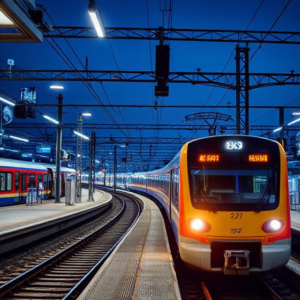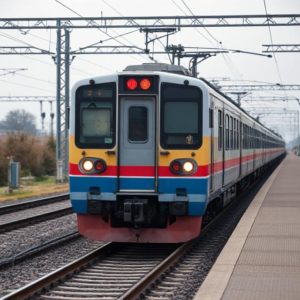Fiber optic communication in railways is a technology that uses light to transmit information over long distances. It involves sending signals through glass or plastic fibers, allowing for high-speed, high-capacity communication. Let me explain it step-by-step, breaking it down:
1. What is Fiber Optic Communication?
- Fiber optics are thin strands of glass or plastic that carry light signals instead of electrical signals (like in copper wires). These fibers are capable of transmitting data at incredibly fast speeds and over long distances without losing signal quality.
- In railways, this technology is used to manage and control systems like signals, communications, and real-time data transfer.

2. How Does It Work?
- Light Transmission: Information is converted into light signals. A laser or LED generates these signals, which travel through the fiber.
- Total Internal Reflection: As the light signal moves through the fiber, it reflects off the walls of the fiber, staying inside the core and traveling long distances without escaping. This process is called total internal reflection.
- Receiver: At the other end, the light signal is converted back into an electrical signal for processing, ensuring that the information is intact.
3. Why Fiber Optic Communication in Railways?
- Speed: Fiber optics offer much faster data transmission than older technologies (like copper wires or radio signals). This is important for things like controlling train movements, monitoring systems, and providing real-time information.
- Reliability: Fiber optic cables are not affected by electromagnetic interference, so they work well even in places with electrical machinery, like train stations or railway yards.
- Capacity: Fiber can handle massive amounts of data. This is crucial for modern railways that need to manage everything from train tracking to passenger services and even Wi-Fi on trains.
- Security: Fiber optics are harder to tap into or intercept compared to traditional cables, making them more secure.
4. Applications in Railways:
Fiber optic communication plays a critical role in various railway functions:
- Train Control and Signaling: Fiber optic cables carry data from sensors, switches, and signals to the central control systems, ensuring trains are routed safely and efficiently.
- Passenger Information Systems: Fiber optics are used to provide real-time updates to passengers, such as arrival times or delays.
- Train Tracking and Monitoring: Fiber optics enable continuous communication between the train and the control center, allowing operators to track train positions and diagnose technical issues in real time.
- Voice and Data Communication: Fiber enables smooth voice communication between stations, control centers, and onboard train crews. It also supports the transfer of operational data.
- Video Surveillance: Cameras along railway tracks or on trains can send high-definition video over fiber optics to ensure security and safety.
5. Advantages in Railways:
- Faster Communication: This helps in efficient operation and better coordination between different stations and train operators.
- Reduced Downtime: Fiber optic systems are very reliable, reducing the chances of communication failures.
- Longer Distances: Fiber optics can carry signals over much longer distances compared to copper cables, which is helpful for covering vast stretches of rail networks.
- Lower Maintenance: Fiber optic cables are durable and require less maintenance compared to traditional cables.
6. Challenges:
- Installation Cost: Installing fiber optics can be expensive, especially if it requires digging up railway tracks or tunnels.
- Vulnerability to Damage: While fiber is durable, it can still be damaged by severe accidents, natural disasters, or improper handling.
Conclusion:
Fiber optic communication helps improve the safety, efficiency, and speed of railway operations by enabling faster data transfer, better connectivity, and real-time communication. It’s a key component in modernizing railways and keeping them running smoothly.
Keywords: Fiber Optics, Railway











